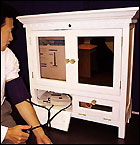The Iraqi desert might seem like the last place on Earth anyone would expect radio-frequency identification to make an impact, but the U.S. Navy has discovered that the technology is the perfect prescription for saving lives. While industry observers speculate about the future of RFID in commerce, the Navy’s Tactical Medical Coordination System, dubbed
TacMedCS, has already demonstrated the viability of the technology in medicine.
Using RFID wristbands on patients, as well as assorted tags and readers in treatment areas, the Navy’s 116-bed Fleet Hospital Three has marched into the 21st century. Patients, who range from U.S. military personnel to POWs and refugees, are fitted with wristbands and given unique ID numbers. When doctors and nurses make the rounds, they scan a patient’s bracelet to confirm his identity, pull up his electronic medical record, and verify they are providing the correct treatment and medication. The TacMedCS program also allows medics to tag and identify the wounded in the battlefield so soldiers can receive the proper treatment in the field and a hospital can prepare for their arrival.
The Navy began using the system when the Iraqi war began last March. Since then, it has improved the quality of care and ushered in a new era of accuracy and accountability. Military medical professionals provide state-of-the-art monitoring using RFID chips from Dallas-based Texas Instruments, smart bracelets from Precision Dynamics, located in San Fernando, Calif., and handheld readers from A.C.C. Systems, an RFID-equipment maker in Glen Head, N.Y. The Navy has subsequently begun testing the system at Fleet Hospital Pensacola, a mobile medical facility based in Florida. “The ability to keep important information with each patient and to track his or her whereabouts automatically have helped medical professionals…better manage patient care,” says the Navy’s chief hospital corpsman, Michael Stiney.
The Institute of Medicine, a Washington, D.C., think tank, estimates that as many as 98,000 people in the United States die each year due to medical errors and that the economic impact may reach as high as $29 billion annually. When the Veterans Health Administration tested Precision Dynamics’ wristband system in 2002 and 2003 throughout its 173 facilities, it reported an 86.2 percent reduction in medication errors. “It’s a way to automate an extremely complex process and reduce the incidence of human error,” says Sean Campbell, a partner in the RFID practice at IBM Business Consulting Services, in White Plains, N.Y.
Yet, despite such promising results, only about 2 to 3 percent of U.S. hospitals currently use the wristbands, according to Irwin Thall, manager for healthcare business development at Precision Dynamics. Most hospitals still use bar codes to track patients or handle the task manually. The bracelets are particularly helpful for monitoring patients who are asleep or those with conditions that make it difficult to use a bar code scanner. They also can help nurses keep track of newborn infants (so they aren’t kidnapped or accidently switched) and patients with Alzheimer’s disease (so they don’t wander off).
Precision Dynamics’ wristbands operate at 13.56 MHz and are compliant with the ISO 15693 standard. They have an RFID microchip and antenna that communicates with standard RFID readers. A facility can generate customized wristbands on demand (costing about $1.25 each) that
include bar codes and color coding, making them compatible with existing bar code applications.
While RFID redefines patient care, it also offers numerous cost and efficiency benefits for healthcare providers and pharmaceutical firms that are struggling to operate more efficiently, track assets more closely, reduce errors and spot counterfeit products. The technology is still in the nascent stages of development, but a growing number of companies are developing innovative solutions that could replace the inefficiencies of paper and manual processes (see RFID in Pharmaceutical Manufacturing).
“There is a huge value proposition surrounding the use of RFID in healthcare,” says IBM Consulting’s Campbell. “Numerous applications and opportunities exist, and the advantages of using RFID in healthcare are already apparent.”
Counting Your Assets
One of RFID’s biggest selling points is that it can automate a dizzying array of processes and provide a more secure way to locate and protect assets—from portable X-ray machines to surgical instruments in a hospital. Unlike bar code systems, which require heavy human involvement and provide little security, RFID can boost the accuracy of data and improve patient safety.
Automated asset tracking is one of the applications garnering attention, says Lyle Ginsburg, a managing partner for technology research and innovation at consulting firm Accenture. By attaching RFID tags to various medical devices—such as scalpels, catheters and forceps—and making them easily identifiable, it’s possible to know what’s in use, where it’s located and whether additional units are available. “It cuts down on accidental reuse errors, and prevents a technician or nurse from using a similar but incorrect piece of equipment,” he says.
One company at the vanguard of RFID asset tracking is Innovision Research & Technology, a Workingham, England, firm that is developing RFID tags that can be embedded in medical equipment. It is collaborating with several medical device manufacturers to develop systems that would ensure that equipment is used to specifications while making it easier for manufacturers to conduct a recall, if necessary. “The goal is to improve traceability and save lives,” says James Urie, Innovision’s business development manager for the healthcare sector.
The firm has introduced an assortment of RFID tags that are small enough (approximately the size of a fingernail and less than 1 mm thick) to fit inside medical devices of almost any shape or size. Because the tags are passive and operate at 13.56 MHz, they provide a great deal of flexibility. A hospital would set up readers at key points, including doorways and passageways. As technicians checked devices in and out, the system would record the action. It also could track the movement of equipment within a facility. Software would provide alerts when it appeared that someone might reuse a disposable device or if a piece of equipment required maintenance.
Canadian manufacturer eXI Wireless, based in Richmond, British Columbia, is now testing wireless asset tags at 22 U.S. hospitals. It estimates that an average hospital loses 20 to 25 percent of its 200 to 250 wheelchairs each year. With the replacement cost of a chair at $400 to $600, that’s $20,000 annually. And that’s only one item among thousands a hospital uses—including pumps, ventilators, gurneys and stethoscopes. Some hospitals are also interested in tracking biomedical materials, says Alan Foster, president of eXI Systems, a subsidiary of eXI Wireless.
Clintrak Clinical Labeling Services, a Bohemia, N.Y., firm, has developed an RFID system designed to ensure the accuracy of clinical trials. Smart labels provide instant verification of items and automate a time-consuming manual process. A clinical trial kit may contain dozens of vials, each bearing a passive RFID tag. A clerk or technician can use an RFID reader to instantly check the vials in each kit and identify if any have been misplaced. Clintrak is currently testing the system and hopes to
release it commercially within a few months. “It is much faster and more accurate than bar code readers,” says Keith Jusas, Clintrak’s vice president of information systems.
Prescription for Success
The same track-and-trace technology could also prove a boon for medical supply firms, pharmaceutical companies and retailers looking to improve their supply chain efficiency. “RFID can help with everything from shrinkage to managing recalls and ensuring the integrity of a product,” says IBM Business Consulting’s Campbell.
RFID is also thwarting counterfeiters. In recent months, the pharmaceutical industry has embraced the technology as a way to find fake, diluted or mislabeled medications, which pose an increasing risk to consumers and also erode public trust of drug makers, says Accenture’s Ginsberg. The Food and Drug Administration estimates that up to 40 percent of pharmaceuticals shipped from countries such as Argentina, Colombia and Mexico may be counterfeit.
The goal is to build a “21st-century system that can better protect consumers against this emerging public health threat,” says Mark B. McClellan, an FDA commissioner. An FDA task force is currently examining the issues and developing recommendations. Fitted with RFID tags bearing Electronic Product Codes (EPCs), products can be traced as they move throughout a supply chain. Each tag would carry a 96-bit or 128-bit “license plate” that identifies the product’s manufacturer, describes the product and includes a unique serial number.
At any point in the supply chain, a manufacturer, distributor or customs agency could scan a tag and check a database to verify the origin of the shipment. If the drug lacks a unique serial number or duplicates an existing number, it’s likely that someone has tampered with the product or introduced counterfeit drugs. The system, which major pharmaceutical companies are now testing, works at the pallet, carton and individual product levels.
In early November, the Healthcare Distribution Management Association, an industry organization that comprises 89 pharmaceutical distributors, issued a position paper encouraging pharmaceutical manufacturers and wholesalers to begin putting EPC tags on cases by the end of 2005 and bottles by 2007. In addition to reducing the volume of counterfeit drugs entering the legitimate supply chain, tagging could also reduce the amount of time and labor spent on complying with regulations.
Among the companies already sold on RFID to thwart theft and counterfeiting is Wal-Mart. In March, the Bentonville, Ark., retailing giant will begin requiring all suppliers of Class 2 drugs—including morphine, OxyContin and Vicodin—to place EPC RFID tags on cases they ship to its pharmacies. FDA rules mandate that companies handling these drugs put strict controls in place. At present, that usually means manually counting cases and bottles. RFID tags would greatly streamline the process.
CVS, a Woonsocket, R.I., pharmacy retailer with 4,087 stores in 33 states and the District of Columbia, is another company that sees enormous opportunity in RFID. In 2000, CVS began exploring the use of EPC technology. According to Jack DeAlmo, CVS vice president of store replenishment and inventory management, RFID can improve efficiency, quality, costs and patient outcome. The
retailer hopes to tag vials and other containers to improve handling processes and speed delivery to customers. CVS is currently testing RFID systems in two stores.
Zebra Technologies, a Vernon Hills, Ill., manufacturer of on-demand printing solutions, is among the companies developing systems to secure the pharmaceutical supply chain. Its labels, tags and printer ribbons support machine-readable data that can’t be erased, altered or duplicated. The company’s print-on-demand smart label stock supports all types of 13.56 MHz and UHF RFID inlays, making it suitable for both current EPC-compliance and future RFID initiatives. The tamper-proof labels would ensure product integrity. “The end goal,” says Chris Hook, director of RFID business development at Zebra Technologies, “is to [secure] the entire pharmaceutical supply chain, from manufacturing to the corner drugstore.”
“The pharmaceutical industry is a logical extension for the same RFID technology that was developed for the packaged goods industry,” says Robin Koh, former associate director of the Auto-ID Center at MIT.
Koh, who has played an instrumental role in developing the technology required for anticounterfeiting, believes that pharmaceutical companies will begin using RFID systems in 2004. Although the hardware already exists, companies are now developing the software and systems to manage the track-and-trace technology. And states and international governments are finally establishing requirements and regulations about how companies can use data. Without such guidelines, drug manufacturers are hesitant to invest in an RFID system.
A Healthy Future
As the technology goes mainstream, it remains to be seen whether patients and privacy groups bristle at the idea of hospitals using RFID wristbands and other tools. The U.S. and other governments mandate the privacy of patients’ medical records. Although the wireless technology offers sophisticated encryption, RFID, like any technology, isn’t completely hack-proof.
AIM, a Warrendale, Pa., trade association for the automatic-identification and data-capture technologies, acknowledges that the privacy of RFID systems has already emerged as a public concern. Last June, it created a privacy workgroup to examine the problem and develop solutions and strategies for protecting privacy and alleviating public concerns within healthcare. “It is important to [educate] those who are unfamiliar with what RFID is and how it works,” says Dan Mullen, the president of AIM, which has 900 members in 43 countries.
While security and privacy concerns are being ironed out, engineers and product designers are beginning to tap into the potential of RFID in the healthcare arena, says IBM Consulting’s Campbell. Accenture Technology Labs, based in Chicago, has developed a prototype smart medicine cabinet that can keep track of medications and dosages, as well as automate reordering. “Pharmacists could attach a passive RFID tag to each prescription, and a reader and computer in the home could manage all the information,” says Dadong Wan, senior researcher at Accenture. Others envision that labs could use RFID to track specimens and waste products, next-generation MediAlert bracelets could carry an individual’s medical record, and implantable RFID chips could monitor key functions for sick patients.
Despite the technology’s remaining hurdles, Accenture’s Ginsburg believes that the healthcare industry is “on the cusp” of seeing RFID adopted in a major way. Increasingly open standards, less expensive products and markedly improved encryption and security bode well for the adoption of RFID. “It is a technology that has tremendous relevance to medicine,” he says. “RFID will save lives and streamline healthcare in remarkable ways.”





